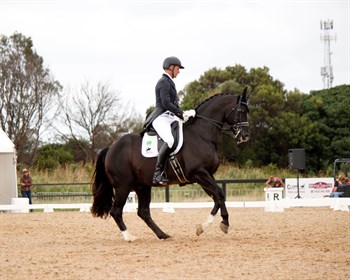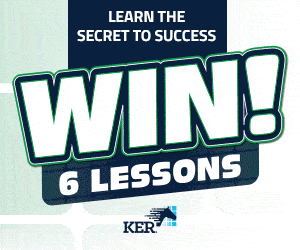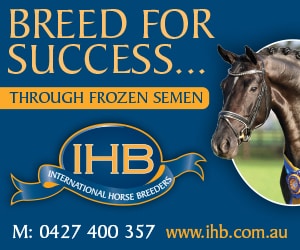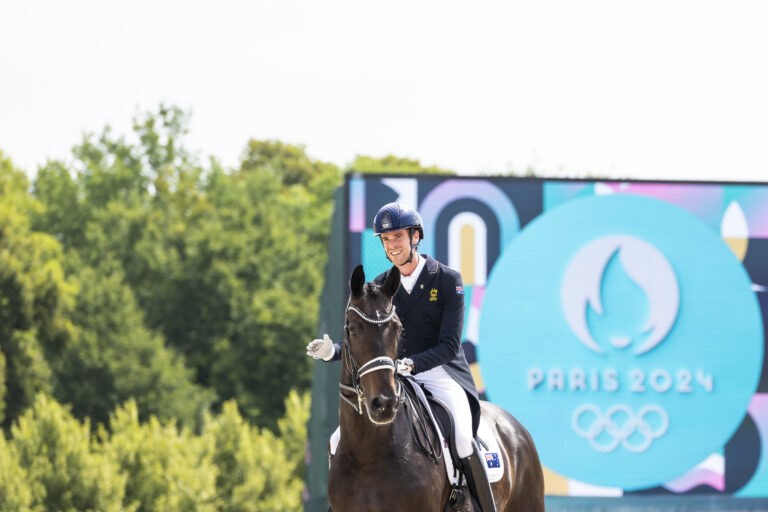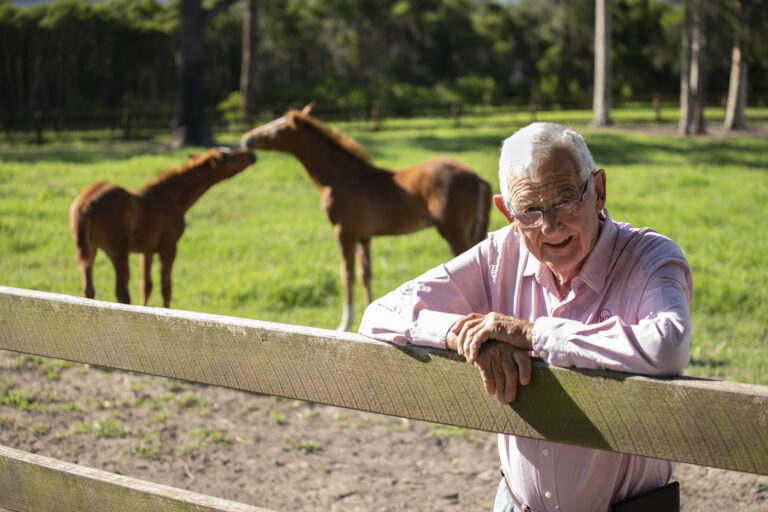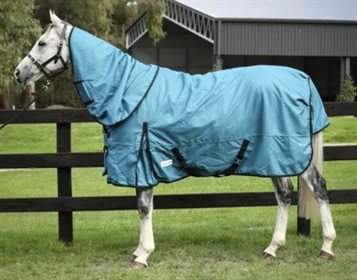The canter pirouette is the end result of many years of gymnastic and collection training. It is a light, slow motion, very collected, cadenced, elevated canter that turns on the hindquarters?in a clear, three beat striding.
© EQ Life
IMPRESSION
By Trevor Ibborsøn-Woodward, Cumbrian Wood Stud
The ULTIMATE in collection, the canter pirouette is a multifaceted mix of training, building blocks and basics that culminates into a very beautiful, graceful movement. A movement which, when correctly executed, shows fluidity and lightness in posture, with the horse appearing to execute the pirouette with ease and effortless synchronization.
The movement requires a soft submissive bend into the direction of the turn, with the horse remaining on the bit with light contact. The horse is able to maintain very good cadence, showing a clear three beat, highly collected, elevated canter that turns on the hindquarters more or less on the spot.
The poll stays the highest point during the entire movement and the horse is always moving forward, in a slow motion like canter, and there must not be any deviation sideways of the haunches.
Judges will be able to see the horse’s ability to?sit (lower haunches) and carry most of the body weight on the hindquarters. A full pirouette will take between 6 and 8 strides to complete with 3 or 4 strides for the half pirouette.
The canter pirouette is a complex movement that is composed of many elements. Should one of these essentials be unsatisfactory, the whole movement will be in jeopardy. Whereas if your pirouette canter (the canter required more or less on the spot for the canter pirouette movement) only gets a “5” then that is what your score for the movement will be.
We have to work on the elements which form the basis of the pirouette step-by-step in a stress free way from the day we start training. If we don’t have these basics established, the scramble to get the finished product is fraught with dangers – overriding, or pushing too hard possibly stressing your horse into thinking it is too hard. If the horse thinks it is excessively hard you have a monumental problem, horses like people, are what they think they are?
FEI Definition Fundamentals of the Pirouette
The pirouette is a turn of 180 degrees (half pirouette) or 360 (full pirouette) deployed on two tracks in canter, with a radius equal to the length to the horses forehand moving around its haunches. The inside hindleg describes a circle as small as possible… The horse is slightly bent in the direction of the turn whilst remaining “on the bit,” with a light contact, turning smoothly whilst maintaining the exact sequence and timing of footfalls. The poll remains the highest point for the entire movement. Fédération Equestre Internationale (FEI) FEI.org
FEI Guidelines
Execution: Executed in the correct place with a straight approach and depart. Correct number of strides – single pirouette 6-8 strides, half pirouette at least 3-4 strides. The outside hind foot should engage and track forward under the body of the horse without any deviation to the outside. The inside hind leg and outside front leg are not touching the ground simultaneously – The pirouette should be centred and the horse should not step out or sideways and not be on a small circle.
Points Deducted
The approach should be straight or with a slight shoulder in position. At least 1 point should be deducted when the approach is quarters in, (this is the most common of all mistakes is to ride haunches-in at the start and ending., Trevor Ibborsøn-Woodward).
If, on the approach, the horse looses the canter for one stride but then regains it immediately deduct 1 point.
Where there is much resistance for example clearly against the bit during the approach or many strides are lost deduct 2/3 points.
If the pirouette or the half pirouette is not quite completed and the departure is therefore crooked the mark would not be higher than 6.
When the horse overturns (spins) and the control is lost the score would never be higher than 4.?The horse should be clearly collected and prepared before the pirouette but not for too long – only 2-3 strides (max 4 strides) – and always in a clear quality three beat canter.?If, in the Prix St Georges, the horse changes before the corner marker the fault should be considered in the mark for
the counter canter and not the one for the pirouette.
This is fairer to the rider as the pirouette has a co-efficient and may have been shown well, and so on. Fédération Equestre Internationale (FEI) FEI.org
FEI Canter Pirouette Elements
Lightness of Aids (Super self carriage)
Ultra Collection (Ability to sit)
Amplification of the hind leg joints (Ability to lift whither and sit)
Rhythm (Slow motion canter)?
Suppleness (Tail to jaw) and more suppleness
Forwardness (In front of the leg) always
Turning smoothly around hindlegs (Inside outside rein relationship) plus suppleness
Poll being the highest point whilst remaining on the bit with light contact (superior control and super self carriage.
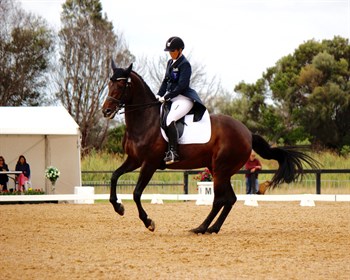
© EQ Life
Early Starting
By starting earlier in the lighter less stressful form on the necessary elements of the canter pirouette you then have the mechanism to build upon to get you and your horse up the levels. Having the building blocks in place, when the time comes for your more comprehensive pirouette work, it is not in a rushed stressful, tiring process for you or your horse as it has already been exposed to multiple elements from your early starter work. Horses do as we do learn quicker by the step-by-step approach and the same applies for learning and teaching the canter pirouette.
By starting these elements early you can gradually build upon them and avoid many of the canter pirouette problems such as: Spinning, Getting Stuck in the Movement, Inability to flex and Bend, Bunny Jumping (hind legs working together,) uneven balance in the canter strides or worse a four beat canter. Start early finish stronger!
Otherwise it is just too late
You need to work on developing all the elements that make up an upper level movement well before you reach it in the tests. It can be something as simple as learning to flex and bend which benefits turning; circles, voltes as well as half pass and canter pirouettes. If you delay it will be too late to introduce the movement in a harmonious stress free way.
All upper level movements have elements that are directly related to a combination basics elements and or lower level movements.
The seemingly innocuous or completely unknown yet all basics have major influence on all upper level movements.
It is a must in dressage for riders and trainers to be aware of these elements and applying them early makes life a lot easier for the horse and rider to develop. Once done all upper level movements come so much easier.
The Performance or Benchmark Factor
The second factor or our benchmark indicators are “walk-canter-walk” transitions. This is the separator between early starter work, from more advanced work. However I stress the starting criteria is only when a horse can easily deploy “walk-canter-walk” transitions consistently and has to be as smooth as silk in its execution.
It is imperative that the quality of this transition must be very high otherwise this would then be reflected poorly in the execution of the half or full pirouette as will your marks.
The horse should not come against the rider’s hand and ought go straight from the walk to canter and back to walk again, seamless and as light as a feather, this is essential as nothing can progress before this comes to pass.
The Age Training Factor
In spite of this even if a youngster (as in a four or five year old horse) can easily do these transitions it is not a sign to start the upper level work. We start the more advanced canter pirouette work around the 6 to 7 years old (3rd or 4th year of training) marker, depending upon the physical and mental condition of individual horses.
Caution: moreover the aforementioned work is seriously hard on the horse’s hocks especially for the 6-7 year olds, so train it sparingly.
Furthermore it takes a lengthy period of time to develop the overall fitness and strength in order to do pirouette canter work.
For example we always start training about 8 to 6 months in advance of competitions using the working pirouette maybe some quarter pirouettes then half pirouettes. We never do this manner of work on a daily basis as it is just too strenuous for the horse.
Movement Factor
Another factor we take into consideration for the more advanced canter pirouette horses is whether the horse understands how to flow, bend and be sideways in the direction of the bend, as in the canter half pass.
If they have a problem with the half pass then there are problems about to occur with the canter pirouette. It’s like the canary in the cage mine early warning scenario that gives insight into potential problems.
Likewise, regardless if it is an early starter or grand prix horse, we firstly ask for a working pirouette to test the horse’s responsiveness to the aids. With the working pirouette we can test and identify any problems and address them before we go too far into the exercise.
Working pirouette is as the name implies in a working canter as distinct to a medium canter, and is the pace we ask for any collected or pirouette canter paces.
We must be able at any given point in time make the horse more active in the hind legs or conversely slow them down sufficiently, place the neck anywhere you want, or improve the balance to the point where you could deploy a smaller pirouettes when asked for, and or go out into a larger pirouette. Then your horse is ready to go into worthwhile canter pirouette work at home.
Be very mindful at the show the performance will not be as crisp as at home. Consequently be prepared to accept this minor reduction in performance and as a consequence don’t override to try and improve it. Accept this is what happens initially that is less than you get at home. To offset his phenomena we often just train the pirouette sequences at a small local show to acclimatize the horse more so to develop a better response and acceptance from the horse in preparation for an upcoming bigger competition.
Play and Fun Starting Early
We always work on the mindset of the horse, so they think what they are doing is easy and fun, not, “oh, this too hard!” When you ask for an early starter element as an exercise, it has to be only a brief exposure, in a non stressful way. It matters little if they make mistakes as we know they will make mistakes as we do, training is about making mistakes, otherwise the horse or we won’t learn.
The real question is how you handle the mistakes. We know that over time, little-by-little and step-by-step, horses will get better. So take your time think ahead and plan what it is you are about to do and how you can calmly rectify mistakes otherwise do something else that does not raise their stress levels. Calmness is the key to learning good positive habits quickly.
If you teach in a playful manner for all your basic training and upper level movements, the horses always see it as fun. The point is that we have to make it enjoyable with lots of praises so that they understand that this OK!
If I’m working lightly, let’s say piaffe, not a correct grand prix piaffe just a playful small attempts always moving forward never on the spot only a few little jog type trot steps, or one or two 3⁄4 to 1⁄2 steps that’s all that is required for a 5-6 year old. As soon as it is done I let them stretch and relax whilst giving lots of positive praise. Just a little here and there and by the time the horse is 8, he or she thinks it is still easy and fun.
Listen to your horse
Too many riders unknowingly work their horse too hard and or too long. This can result in lactic acid build up, causing the horse pain. If not addressed correctly, your horse can tie up which can result in irreparable muscle damage and is a definite no, no!
The great Carl Hester as do many other great trainers do always asks their horses or riders for walk rest breaks.
In early starter canter pirouette in fact all exercises, we have to be aware that what we thought was easy for our horse the day before, may not be so today.
When riding your horse every day, you start to feel your horse in your hands and you start to listen to the feel – you will know from the feel whether or not everything is OK.
Be Sensitive – Be Smart
Should your horse all of sudden start to feel a little heavier in the hand or not so good through the back than they normally do, then this is the time to think and react. Maybe today you will need to do some easy work as your horse is not as free as they normally are. You can push them more tomorrow but not today.
He or she might be giving you signals that they may have worked too hard the previous day or perhaps they have played too hard in their paddock or have been cramped up in the stable?
When this happens or you suspect something is not quite right, you might be advised to ride them deep and low, making them more comfortable to keep them willing to work for you. Then the next day he/she might be able to come up a little more so and work up to their training level.
Nothing is permanent when riding and training horses, nature has its own timeline that does not necessarily fit in with our or competition training schedules.
However, If you are riding/training a horse that is more sensitive or hotter than usual then you have to look at ways of making that particular day more relaxing and less stressful. Every day is a new day for horses and it is up to us to work out what exercises suit the mental and physical state of our horses in order to be successful, safe and injury free.
Sorry, that is all for this month. We have run out of time and space. Look forward to next month’s lesson for part 2 of starting early pirouettes. We will cover aspects of the relationship of walk pirouettes to the canter pirouette and some handy exercises for you.
Talk soon.
0429 638 511
trevor@cwsperformancehorses.com
www.cwsperformancehorses.com
READ THE LATEST NEWS ARTICLES HERE

